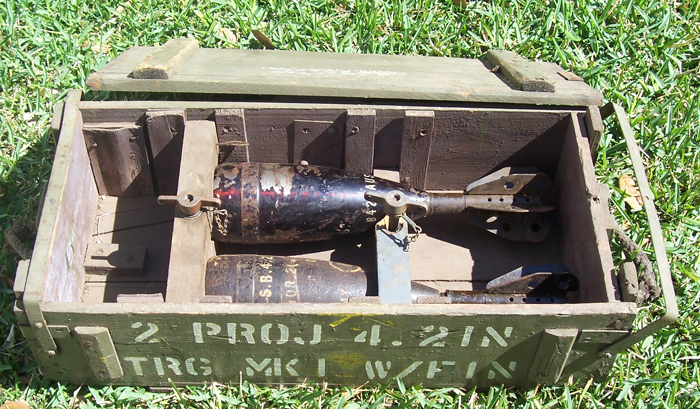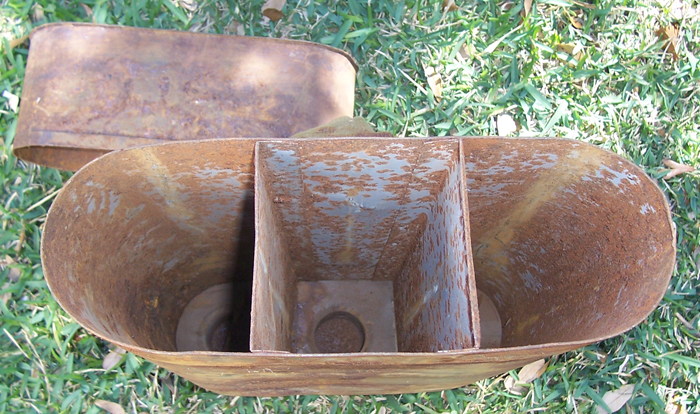
 |
|
#1
|
|||
|
|||
|
Hi all: somebody can send me a good pic of the british ( not the american M30) 4,2" mortar?. Any help to find 4,2" Shell canisters?. Best regards
__________________
1:1 scale T-16 |
|
#2
|
||||
|
||||
|
By shell canisters, do you mean the bodies of 4.2" mortar rounds or items used to store and carry the rounds?
__________________
David Gordon - MVPA # 15292 '41 Willys MB British Airborne Jeep '42 Excelsior Welbike Mark I '43 BSA Folding Military Bicycle '44 Orme-Evans Airborne Trailer No. 1 Mk. II '44 Airborne 100-Gallon Water Bowser Trailer '44 Jowett Cars 4.2-Inch Towed Mortar '44 Daimler Scout Car Mark II '45 Studebaker M29C Weasel |
|
#3
|
|||
|
|||
|
|
|
#4
|
|||
|
|||
|
Hi Horsa, i find the tubes used to store and carry the rounds, always I have seen them joined in couples.
I attached the pic of the 4,2" mortar carrier that i want recreate. It carried a lot of round tubes. I want a 4,2" deactivated round too, but is complicate import it, i can import a 2" deac.roud, but whit the fins and the head in separated parcels. Best regards
__________________
1:1 scale T-16 |
|
#5
|
||||
|
||||
|
That photo and the others in the same series of Canadian Mortar Carriers has a lot of good details in them. There are numerous modifications visible on each of the vehicles which differ from the standard British and Canadian T-16. All five of the vehicles have a piece of roughly 2" x 2" angle iron bolted on the side in place of the track skirts. A very practical modification since it allows people to climb in and out easily anywhere along the side and still blocks some of the mud that flings off the tracks.
The part hanging on the gunner rear side of the vehicle is an adapter for the normal 4.2" base plate as they tended to press themselves into the ground during prolonged firing. For the tubes for rounds, those in the photo should be bundles of two each which was standard for the 4.2" pattern during the war. Even the much larger wooden crates only held two rounds each. There is one other type of carrier for rounds which is made of metal which holds three rounds and it was designed to be carriered as a backpack. It is supposed to be for airborne troops but I have so far found no good documentation on it. I have one here and will try to take photos and post them this weekend for you to see along with what the crates look like. As for 4.2" rounds, I have a small number still available with two being 1944 dated and six being postwar dated. Same style which is the streamline body. No fuzes left unfortunately. Fins can be removed for shipping on their own if that makes them work for you to receive them in your country.
__________________
David Gordon - MVPA # 15292 '41 Willys MB British Airborne Jeep '42 Excelsior Welbike Mark I '43 BSA Folding Military Bicycle '44 Orme-Evans Airborne Trailer No. 1 Mk. II '44 Airborne 100-Gallon Water Bowser Trailer '44 Jowett Cars 4.2-Inch Towed Mortar '44 Daimler Scout Car Mark II '45 Studebaker M29C Weasel |
|
#6
|
||||
|
||||
|
Shots below of the standard two round wooden crate for holding 4.2" mortar rounds and the metal backpack that held three rounds. Both items need restoration but are back burner projects for now. The two rounds in the crate are 1944 production and have no fuzes in them. Fuzes and the launching cartridges in a tin would account for the open space in the crate at one end.
  
__________________
David Gordon - MVPA # 15292 '41 Willys MB British Airborne Jeep '42 Excelsior Welbike Mark I '43 BSA Folding Military Bicycle '44 Orme-Evans Airborne Trailer No. 1 Mk. II '44 Airborne 100-Gallon Water Bowser Trailer '44 Jowett Cars 4.2-Inch Towed Mortar '44 Daimler Scout Car Mark II '45 Studebaker M29C Weasel |
|
#7
|
||||
|
||||
|
show off
 took my aussie carrier out for a drive today,,, suprise no fire, smoke or sparks this time  DD
__________________
44 GPW, 43 MB, 42 trailer, 43 cckw 44 MORRIS C8, M-3A1 SCOUT CAR 41 U/C, 42 U/C x 2, 44 U/C 42 6LB GUN and the list keeps growing, and growing.... i need help LOL |
|
#8
|
|||
|
|||
|
Hi Horsa: you can send me a pics of a round? Do you sell one?I suppose that they will be empty(deactived). I want to see if beside removing the fins, some another piece is necessary to remove (the detonator for example) that reveals that they are rounds.
The problem is that though I am an authorized collector, the personnel of the customs do not ask and if they have doubts, directly they do not deliver the parcel without warning myself .How much do you want for one round ( ww2 and post dated)?,can you let me know the two separate parcels ( finds an body) shipping cost?. i donīt understand if you have only the wooden crates, or have tubes for rounds ( twins) too. I saw that you have a t16, can you send me pics to my mail: florprien@hotmail.com?. If you write me throught your personal mail, i can send to you pics of mine T16, if you have interest in see it. Thanks for your help, best regards. Juan Marelli
__________________
1:1 scale T-16 |
|
#9
|
|||
|
|||
|
Hi horsa, i saw this reply after send my message, well, i saw the round and separating the fins whit the main body, i can receipt them whitout problem, donīt need anyother work to hidden it ( well, if the parcel label donīt declare MORTAR SHELL).
A wood crate is a good choice to replace the conteiner that i saw. Do you have one of this to sell. Where can find a good 2" mortar (repro or real) to attached to my carrier as smoke launcher?. Thanks for your help. Whitout yours replys ( all the forum member are very polite), will be almost impossible for me to restorate my t16 as canadian. Best regards
__________________
1:1 scale T-16 |
|
#10
|
||||
|
||||
|
Hey Juan,
The wooden 4.2" crate is from my own collection and I don't have a spare to sell or trade. I do have a few of the 4.2" mortar rounds available for sale though which I have been selling for a friend. There are two 1944 dated rounds and six postwar rounds available. I will post photos and details to your direct eMail along with some shots of my T-16 as it is slowly progressing with the restoration. I'd also like to see photos of your T-16 so you can post them back to my eMail once you get the shots from my account. I don't have a set of the cardboard tube carriers for 4.2" rounds but have handled a single set once a few years ago. The length of the carboard tubes is 21.25" long and they need an inside diameter able to hold a round so for building them, you'd probably need to use whatever cardboard tubing that you could find in a stock size. Likely something around 4.5" diameter I'd guess. Overall construction would be the same as the tubes used for 3" mortar rounds except there would only be two instead of three.
__________________
David Gordon - MVPA # 15292 '41 Willys MB British Airborne Jeep '42 Excelsior Welbike Mark I '43 BSA Folding Military Bicycle '44 Orme-Evans Airborne Trailer No. 1 Mk. II '44 Airborne 100-Gallon Water Bowser Trailer '44 Jowett Cars 4.2-Inch Towed Mortar '44 Daimler Scout Car Mark II '45 Studebaker M29C Weasel |
|
#11
|
|||
|
|||
|
Hi mate: i will try to copy a wooden crate or a cardboard tube , your pic is a great help for the task. I donīt know if the shell is dated, so i donīt have a preference. Do you have interest to sell to me one round? i donīt have any hurry, my proyect need a long, long work. Then if your you decide to sell a round( if the shell donīt have any war or post war identification, the cheapest is good for me), please make me know its price, as well as the expense of sending to argentina. I belive that the surface option is the best, ( remembers divided in two parcels). Then if i can pay the price, and you have a bill of paypal, I can send the money, or it can be for western union, but it is more expensive for me and you have to be going to look for the money to the western union office.
I donīt know well the rules of the forum, so if you canīt make bussines thought open reply, send me a mail to juanprien@hotmail.com. Sorry for my english, and thanks for your effort to understand me. Best regards.Juan
__________________
1:1 scale T-16 |
 |
|
|